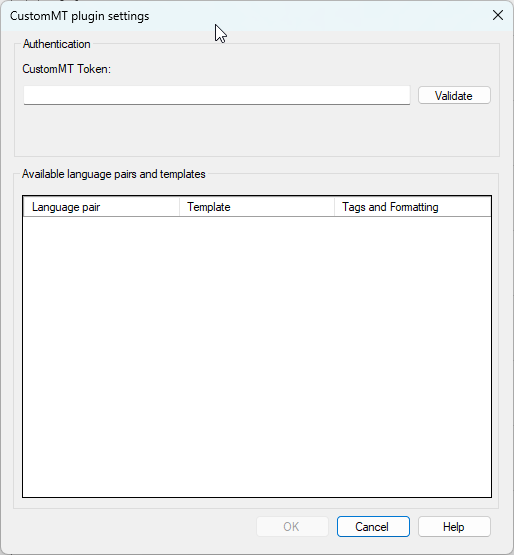Custom.MT plugin settings
Custom Machine Translation (Custom.MT) is an AI and machine learning operations agency. The company specializes in helping translation and localization teams implement AI models.
To learn about how Custom.MT handles your data: Read their privacy policy.
How to get here
-
At the top of the memoQ window, click the Resource console
 icon. The Resource console window opens.
icon. The Resource console window opens. -
In the Server URL list, choose or type the server's address.
To see local resources only, choose My computer, and click the Select
 button.
button. -
In the left-side pane, click the MT settings
 icon. The MT settings pane opens.
icon. The MT settings pane opens.If you have projects with more than one target language, in the top-right corner, choose a language from the Target language dropdown list.
If you want to use the same MT settings for all target languages, don't change the default value (All languages).
-
Select the MT settings resource and click Edit under the list.
-
On the Services tab, find the plugin and click its row.
-
If it's active, click its row to open the Custom.MT plugin settings window.
-
If it's grayed out, click its row once to turn it on, then click it again to open the settings.
-

What can you do?
Prepare for using the Custom.MT service in memoQ
-
Register on the Custom.MT console website, then sign in with your username and password.
-
On the Templates page, create templates for the language pairs you use in memoQ. These templates are combinations of language pairs, MT engines (or LLMs, large language models), and various options.
Set up the Custom.MT service in memoQ
-
First, paste your API key into the Custom.MT token text box, and click the Validate button.

-
The list of templates you created on the Custom.MT console appears in the Available language pairs and templates section.

-
For each language pair, choose a template and how you want to handle tags and formatting.
Normally, when memoQ sends text to Custom.MT, the tags are not sent. The translation you get back from Custom.MT will not contain any tags. memoQ will insert all the tags at the end of the machine-translated text.
- To use no formatting and no tags: Choose None.
- To use formatting but use no tags: Choose Only formatting.
- To use both formatting and tags: Choose All.
Choices in the Custom.MT template also affect tag handling. When creating the template, choose the settings accordingly.
When you finish
To save the settings and return to the Default resources tab of the Options window (or to the Resource console): Click OK, then click OK again.
To return to the Default resources tab of the Options window (or to the Resource console), without saving the new settings: Click Cancel, then click Cancel again.
To use the MT output in the translation editor:
- Open a project with a supported language pair.
- On the left side of the Project home or memoQ online project screen, click Settings.
- In the top bar, click the MT settings
 icon.
icon. - Choose the MT profile in the project, or one you want to add to the project. Below the list, click Edit.
- On the Services tab of the Edit machine translation settings window, check the plugin's checkbox on the left.
- On the Settings tab of the Edit machine translation settings window, in the Translation results area, choose a setting other than Off.
- Open a document for editing, and see the machine-translated suggestions.
To use the MT output in pre-translation:
- Open a project with a supported language pair.
- On the left side of the Project home or memoQ online project screen, click Settings.
- In the top bar, click the MT settings
 icon.
icon. - Choose the MT settings resource in the project, or one you want to add to the project. Below the list, click Edit.
- On the Services tab of the Edit machine translation settings window, check the plugin's checkbox on the left.
- On the Settings tab of the Edit machine translation settings window, select the plugin from the Pre-translation dropdown.
- Run Pre-translate. In the Pre-translate and statistics window, select the Use machine translation if there is no TM match checkbox. (memoQ will remember this.)